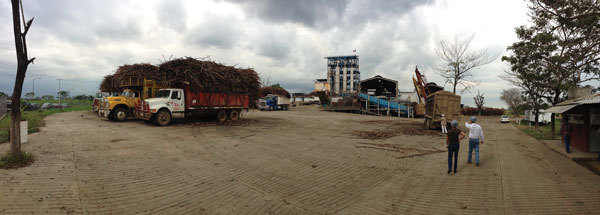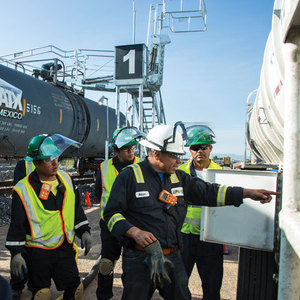How to Build a Market




PHOTO: TERMINAL DEL CENTRO DE MEXICO
October 19, 2017
BY Lisa Gibson
When the news broke in June, Kristy Moore made an unscheduled trip to Mexico to get back to work on the next steps in building a market. Mexico’s Regulatory Commission on Energy (CRE) had announced it would allow up to 10 percent ethanol in gasoline across most of the country, and Moore, president of KMoore Consulting LLC and working closely with the U.S. Grains Council, had been active for more than a year to encourage the change.
“They’ve taken our advice, understand the benefits to them and they have a fungible fuel specification so that they can directly import gasoline from the United States,” Moore says.
Since the June announcement, Moore and her counterparts across the U.S. ethanol and gasoline industries have been teaming up with Mexican officials and agencies to forge ahead with the next steps in developing a new market. That market represents a 1.2 billion-gallon opportunity for the U.S., says Ryan LeGrand, a Mexico-based director for the USGC.
The market, technically, is open today and Moore and LeGrand say some companies in Mexican border states likely already are sending trucks across the border, purchasing blended gasoline and bringing it back. But farther south, the infrastructure is lacking and desperately needs to be built out before a healthy ethanol market is established. Retailers need information about selling and blending ethanol, and widespread myths about ethanol need to be debunked. E10 is still banned from the country’s three largest metro areas—Mexico City, Guadalajara and Monterrey—while the government conducts a closed study into ethanol’s impacts on its most polluted cities.
Even with all that’s been accomplished, there’s plenty more work to do.
So, how does a new market get developed and where are we in the process? Moore outlines four steps: update fuel specifications; build the infrastructure; educate retailers; and make the product financially attractive. They don’t necessarily happen in a cut-and-dry order, and most are happening simultaneously. Right now.
Fuel Specifications
The push to educate and debunk ethanol myths in Mexico began in 2016, according to Moore. The country already was reevaluating its current policies and fuel market, prompted by a desire for more competition—the industry was dominated by government-owned gasoline supplier Pemex, which controlled the fuel price. Ethanol was prohibited nationwide, based on a negative reputation perpetuated by the MTBE industry, so some organizations teamed up to present the facts. They included the USGC, Growth Energy, the Renewable Fuels Association and the American Coalition for Ethanol, among others, as well as agencies such as the Mexican Association for Sustainable Mobility & Generation. “We’ve spent a year telling them about what ethanol does and doesn’t do,” Moore says.
In August of 2016, the CRE published proposed national fuel specifications, which included ethanol blending, but only up to 5.8 percent by volume, and maintained the ethanol prohibition in the three main cities, based on questions about how ethanol would affect their air pollution. “In our minds, we thought we had failed in our education,” Moore says.
USGC, the Mexican Association for Sustainable Mobility & Generation and their partners submitted extensive comments about the fuel blend volume and the fact that ethanol is needed most in Mexico’s three most volatile ozone areas. In December, the CRE initiated monthly work group meetings to discuss issues with the national fuel specification. “It was an amazing process,” Moore says, adding all her counterparts working on the fuel industry in the U.S.—Tesoro, Chevron, BP, Valero and more—would make the trip to Mexico for the monthly meetings, all working to help ensure Mexico’s fuel specifications would be beneficial to their product.
In April, the Mexican Association for Sustainable Mobility & Generation submitted an official proposal to the CRE to increase the volume to 10 percent and remove the prohibition in the three major cities. “Mexico has been increasingly relying on the U.S. fuel producers to fulfill the market’s needs,” says Stephan Wittig, president of the Mexican Association for Sustainable Mobility & Generation. “This year, over 60 percent of liquid transportation fuels have been imported from the U.S. Allowing E10 gives not only access to cleaner fuels because of ethanol, but also because of having access to the same lower sulfur fuels being sold in the U.S.”
Then, in June 2017, the CRE released its emergency ruling allowing E10, but keeping the ban in Mexico City, Guadalajara and Monterrey, pending a closed government study of ethanol’s emissions, to take place at the Mexico Petroleum Institute. Moore says she’s cautiously optimistic about the study, but adds the elevation, number of vehicles on the roads and fuel composition are all wild cards in the analysis.
LeGrand says he hopes results will be released by the end of the year. He says the myth that ethanol contributes to ozone is the biggest fear and obstacle to overcome in Mexico. “We need to dispel the myth and allow blending in those three major cities.”
Moore points out that the swift E10 allowance was in large part attributable to support from the Mexico Department of Energy (SENER). “This would not have come to fruition in such a short time frame had SENER not understood the benefits of ethanol and intervened to support its introduction.”
So with the results and ruling for the three cities on the way, E10 is allowed in the rest of the country but is hindered by inadequate infrastructure. Pemex has no plans to produce ethanol, Moore says, and owns all the country’s fuel rail terminals, meaning an almost entirely new infrastructure must be built from scratch. “Today, Pemex is the only game in town. They’re the only ones who own terminals, tanks and any pipelines and ports. So there’s no infrastructure down there.”
Infrastructure and Education
“Our next effort in Mexico is to build the infrastructure,” Moore says. “There are dozens of infrastructure projects being built.”
Jorge Wade, director of Terminal de Centro del Mexico, says several terminals are under construction all over Mexico and will be ready within the next couple of years. TCM is working with Watco to design, build and operate a terminal in San Luis Potosí, in central Mexico. The terminal will be able to receive unit trains and store up to 1.2 million barrels of fuel, he says. “TCM is now ready to transload product from rail car to trucks directly and will be ready to store by quarter two 2018,” Wade says. “Our offer is flexible and can receive finished products or also have the possibility to blend on site, depending on customers’ needs.”
Wade says the terminal-building industry is excited about the new market and infrastructure, siting rail track builders, pipelines, storage, automation, software and security sectors. The buildout process is a long one and LeGrand expects the first terminals to be online later next year.
Moore says, beyond physical infrastructure construction, work also is being done to educate on the ease of converting existing terminals to accommodate ethanol handling. Educational workshops already are being conducted with retailers to outline the benefits and guidelines for E10 handling. “This will allow a seamless transition towards the use of E10 fuels,” Wittig says. Moore says the first retailer conversion workshop she held netted 110 attendees, despite the fact that the invitation only went out to 50. “It was wonderful,” she says. “Retailers are excited about having more supply options and being able to differentiate themselves and build their own businesses.”
But setting up access for U.S. ethanol producers and fuel suppliers isn’t the only goal. For the market to take off, the country needs its own domestic production, too. “Mexico represents a very interesting potential market for us,” LeGrand says. “It’s a 1.2 billion-gallon potential market. But I also believe that people need to know that for ethanol to be widely accepted in Mexico, and for us to continue to see policies that push additional ethanol consumption in Mexico, we have to see growth in Mexican ethanol production as well. The government is trying to set up a new industry down here and we’re trying to support that as well. So the Grains Council is down here to not only promote imports of U.S. ethanol, but to also help the Mexican industry in any way that we can. For this to work, we need to see a win-win situation on both sides.”
Moore agrees and adds that the U.S. ethanol industry is the best and most efficient in the world, perfectly positioned to help Mexico set up its own. “Our ethanol fermentation and production process is the most advanced in the world,” she says. “We get the highest yield for the lowest energy and the most efficient use of grain. And we can teach them how to do that in Mexico.”
Benefits at Home
Ethanol’s benefits to Mexico will be numerous, Wittig says. The secure ethanol source from the U.S., just a train ride away, is a no-brainer for refiners that will jumpstart the ethanol blending program while the Mexican industry starts to grow, he says. But there’s much more.
“In general, the use of ethanol will bring to Mexico the same air quality benefits that have been proven in over 60 countries around the world that have implemented biofuel programs,” Wittig says. “Ozone, toxics and particulate matter level reductions are among the first observed results in highly polluted cities that implement ethanol blending. Moving close towards the country’s goal on GHG emissions reductions committed to in the COP21 in Paris is a big step, also.”
And the use of competitively priced ethanol will allow Mexican consumers to save between 20 and 40 centavos (4 and 6 cents) per gallon, Wittig says. “Private sector is involved,” Wade says. “The reform is allowing private sector to participate in the energy industry. This generates new investments, efficiencies, jobs and competition.” It also gives the country’s capacity a boost from the one- to three-day supply it’s been used to, up to 15 days, he says.
“A safer water supply for the country is also an effect of allowing ethanol blended fuels, since other toxic components will be replaced,” Wittig says.
The legislative groundwork is laid, the infrastructure buildout and education campaign are in action, and the financial attraction is clear. The market is setting up to be the win-win LeGrand says is ideal for both parties.
“I can see a situation in the future where we have a very large export market for U.S. ethanol, and Mexico, at the same time, is able to have success in growing their industry here at home and create jobs, which obviously has further implications.”
Author: Lisa Gibson
Managing Editor, Ethanol Producer Magazine
701.738.4920
lgibson@bbiinternational.com
Advertisement
Advertisement
Advertisement
Advertisement
Related Stories
U.S. fuel ethanol capacity fell slightly in April, while biodiesel and renewable diesel capacity held steady, according to data released by the U.S. EIA on June 30. Feedstock consumption was down when compared to the previous month.
XCF Global Inc. on July 8 provided a production update on its flagship New Rise Reno facility, underscoring that the plant has successfully produced SAF, renewable diesel, and renewable naphtha during its initial ramp-up.
The U.S. EPA on July 8 hosted virtual public hearing to gather input on the agency’s recently released proposed rule to set 2026 and 2027 RFS RVOs. Members of the biofuel industry were among those to offer testimony during the event.
The U.S. exported 31,160.5 metric tons of biodiesel and biodiesel blends of B30 and greater in May, according to data released by the USDA Foreign Agricultural Service on July 3. Biodiesel imports were 2,226.2 metric tons for the month.
The USDA’s Risk Management Agency is implementing multiple changes to the Camelina pilot insurance program for the 2026 and succeeding crop years. The changes will expand coverage options and provide greater flexibility for producers.
Upcoming Events










